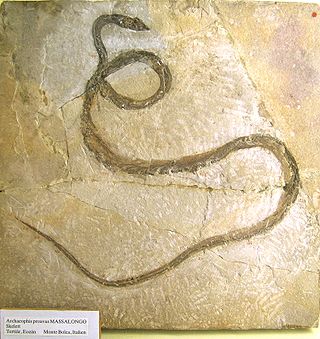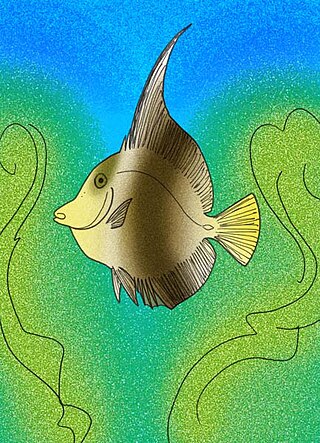
Monte Bolca is a lagerstätte near Verona, Italy that was one of the first fossil sites with high quality preservation known to Europeans, and is still an important source of fossils from the Eocene.

Pycnodus is an extinct genus of ray-finned fish from the Eocene period. It is wastebasket taxon, although many fossils from Jurassic or Cretaceous are assigned to this genus, only Eocene species, P. apodus is valid. As its name suggests, it is the type genus of Pycnodontiformes.

The moonfish of the genus Mene, the sole extant genus of the family Menidae, are disk-shaped fish which bear a vague resemblance to gourami, thanks to their thread-like pelvic fins. Today, the genus is represented only by Mene maculata of the Indo-Pacific, where it is a popular food fish, especially in the Philippines, where it is known as bilong-bilong, chabita, hiwas or tahas.

Bolca is a village in the Veneto, on the southern margin of the Italian Alps. It is a frazione of the comune of Vestenanova, in the province of Verona. The area is famous for the marine fossils from the lagerstätte of Monte Bolca. It was one of the first fossil sites with high quality preservation known to Europeans, and is still an important source of fossils from the Eocene.

Urolophus is a genus of round rays mostly native to the western Pacific Ocean and the Indian Ocean, though one species occurs in the Pacific waters of the Mexican coast. Müller and Henle erected Urolophus in an 1837 issue of Bericht Akademie der Wissenschaften zu Berlin. The name is derived from the Greek oura, meaning "tail", and lophos, meaning "crest". In Urolophus, the outer rims of the nostrils are not enlarged into lobes, but may form a small knob at the back.

Proaracana dubia is an extinct, prehistoric aracanid boxfish that lived during the Lutetian of middle Eocene Monte Bolca.

Spinacanthus cuneiformis is an extinct prehistoric tetraodontid bony fish that lived from the Lutetian epoch of Eocene Monte Bolca.

Aeoliscoides is an extinct genus of prehistoric ray-finned fish that lived from the early Eocene. It is known from a single species, A. longirostris, from the famous Monte Bolca site of Italy. It was a member of Centriscidae, making it a relative of modern shrimpfish and snipefish. Its name references its close resemblance to the extant shrimpfish genus Aeoliscus.
Aulostomoides is an extinct genus of prehistoric marine ray-finned fish from the early Eocene. It contains a single species, A. tyleri from the Monte Bolca site of Italy. It is thought to be a member of Aulostomoidea, making it a relative of trumpetfish and cornetfish.
Aulorhamphus is an extinct genus of prehistoric marine ray-finned fish that lived from the early to middle Eocene. It contains four species known from the Early Eocene of Italy and the Middle Eocene of Russia. It was an aulorhamphid, an extinct family of syngnathiform fishes.
Anguilloides is an extinct genus of prehistoric marine eel that lived in the early Eocene. It contains a single species, A. branchiostegalis. Fossils are known from the famous Monte Bolca site of Italy.
Paranguilla tigrina is an extinct prehistoric eel that lived during the Lutetian epoch of the Eocene, in what is now Monte Bolca.

Bolcyrus is an extinct genus of prehistoric bony fish that lived from the early to middle Eocene.

Ductor is an extinct genus of prehistoric ray-finned fish that lived from the early to middle Eocene. Fossils are found in Monte Bolca.

Eolactoria sorbinii is an extinct prehistoric boxfish that lived during the Lutetian epoch of the middle Eocene, in Monte Bolca. It had two pairs of long spines, one over each eye, and one pair beneath the anal and caudal fins, arranged very similarly to those possessed by the modern genus Lactoria, but were, in comparison, much longer. E. sorbinii had a fifth spine between the two eye-spines, arranged and looking very much like a nose.

Eozanclus brevirostris is an extinct relative of the Moorish idol that lived during the late Ypresian epoch of the Eocene in what is now Monte Bolca, northern Italy. It differs from its living relative by having a much shorter snout.

Eoplatax is an extinct genus of prehistoric spadefish that lived during the Lutetian of Monte Bolca. They are closely allied to the extant genus, Platax, more commonly known as "batfish."
Acanthopygaeus is an extinct genus of prehistoric marine perciform fish in the family Siganidae. It is known from the Eocene lagerstätte "Pesciara" in Bolca, Italy.

Protobalistum imperiale is an extinct prehistoric tetraodontid bony fish that lived from the Lutetian epoch of Eocene Monte Bolca.

Spinacanthidae is an extinct prehistoric family of tetraodontid bony fish that lived from the Lutetian epoch of Eocene Monte Bolca.













